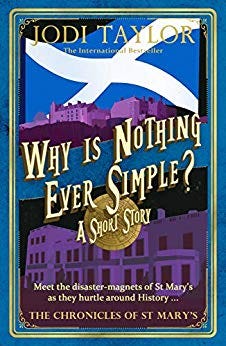The Battle of Bannockburn: A Turning Point in Scottish History
Featured in Why is Nothing Ever Simple? by Jodi Taylor
AI-generated audio has been added for accessibility.
The Battle of Bannockburn, fought on 23rd and 24th June 1314, was a defining moment in Scottish history, securing Scotland’s independence from English rule. This battle, led by King Robert the Bruce against the forces of King Edward II of England, was one of the most significant victories in Scotland’s struggle for independence during the First War of Scottish Independence (1296–1328). It not only cemented Bruce’s authority as King of Scots but also weakened English dominance in the region.
The battle took place in the context of a long and bitter conflict between Scotland and England. In 1296, King Edward I of England – known as the Hammer of the Scots – invaded Scotland, seeking to bring it under English rule. This led to years of resistance, with figures such as William Wallace and later Robert the Bruce leading the fight for Scotland’s independence.
By 1314, Bruce had gained control over much of Scotland, but the castle of Stirling, a key strategic fortress, remained in English hands. The governor of Stirling Castle, Philip Mowbray, had agreed to surrender if an English relief force did not arrive by 24th June 1314. In response, King Edward II gathered a massive army, estimated to be around 15,000–20,000 soldiers, including heavy cavalry, longbowmen, and infantry, and marched north to relieve the castle. Robert the Bruce, with a much smaller force of 6,000–8,000 men, prepared to confront the English at Bannockburn, near Stirling.
The Battle: 23rd–24th June 1314
Day One: 23rd June 1314
As the English army approached, they encountered the Scots positioned in a marshy area with dense woodland, which restricted movement, particularly for cavalry. Bruce, a skilled tactician, had prepared the battlefield by using the natural landscape to his advantage.
One of the most famous moments of the battle occurred on the first day when Robert the Bruce faced the English knight Sir Henry de Bohun in single combat. Bohun, spotting Bruce on a small horse, charged at him with a lance. At the last moment, Bruce sidestepped and struck Bohun with his axe, killing him instantly. This act greatly boosted Scottish morale.
The English vanguard attempted to advance but was forced back by Scottish spearmen, organised into schiltrons—tight defensive formations of men with long spears. These tactics had been effectively used in previous battles against English cavalry, and once again, they proved successful.
The first day ended with the Scots holding their ground and the English forces in disarray.
Day Two: 24th June 1314
Edward II ordered a full-scale attack the next morning, expecting to break through Scottish lines. However, Bruce’s forces were well-prepared.
The Scots, positioned in narrow terrain between Bannock Burn (a small stream) and the New Park (a wooded area), forced the English into tight formations, limiting their mobility. The English longbowmen, a key asset in previous battles, were unable to operate effectively due to the confined space and were eventually driven off by Scottish cavalry.
As the battle intensified, the English knights and infantry became trapped in the marshy ground, struggling against the unyielding Scottish schiltrons. Panic spread through the English ranks, and their retreat turned into a disastrous rout. King Edward II barely escaped, fleeing with a small group of knights, while thousands of English soldiers were killed or captured. It’s thought that barely 3000 English soldiers made it back to English soil.
The victory at Bannockburn paved the way for the Treaty of Edinburgh-Northampton (1328), in which England formally recognised Scotland’s independence and Bruce’s kingship. The battle also became a powerful symbol of Scottish resistance and national identity, remembered for centuries in Scottish history and culture.
The Battle of Bannockburn remains one of the most celebrated battles in Scottish history. It has been immortalised in literature, poetry, and national commemorations, including the famous poem "Scots Wha Hae" by Robert Burns.
Today, the site of the battle is home to the Bannockburn Heritage Centre, where visitors can learn about this pivotal moment in history through interactive exhibits and battlefield reconstructions.
Discover how the team from St Mary’s fared at the Battle of Bannockburn in Why Is Nothing Ever Simple? by Jodi Taylor
We hope you have enjoyed this History Briefing - please CLICK HERE to read more background history from The Chronicles of St Mary’s series by Jodi Taylor.
Have you discovered The Official Reading Companion and History Briefings for The Chronicles of St Mary’s series by Jodi Taylor?
If you've ever found yourself wondering who did what, when, and where in Jodi Taylor’s brilliant Chronicles of St Mary’s series — this is the companion guide you’ve been waiting for.
This guide is a must-have for both dedicated fans and curious newcomers. It contains synopses of every book and short story, detailed floor plans of St Mary’s Institute for Historical Research, History Briefings, chronological jump lists, character information, and more.
Whether you’re brushing up on the timeline or want to immerse yourself further in the chaos and charm of St Mary’s, this guide is your ultimate companion.
CLICK HERE to learn more.





I think it's worth mentioning that Stirling Castle is set on the top of a huge volcanic plug - almost impossible to take, but vulnerable to siege and being starved out. That's why the English were not storming the ramparts as is usuall with attacks on a castle. Furthermore, Edward II was a poor substitute for his father. He had tremendous problems with mobilising troops and also with being trusted in the battlefield. He had unsuitable friends and alienated many of the the barons, his natural supporters. I think it's surprising that the battle lasted two days. King Robert was a masterful battlefield strategist and tactician, unlike his opponent. If it had been Edward I not Edward II, it might have been very different! Incidently, Edward II was the very first English Prince of Wales.